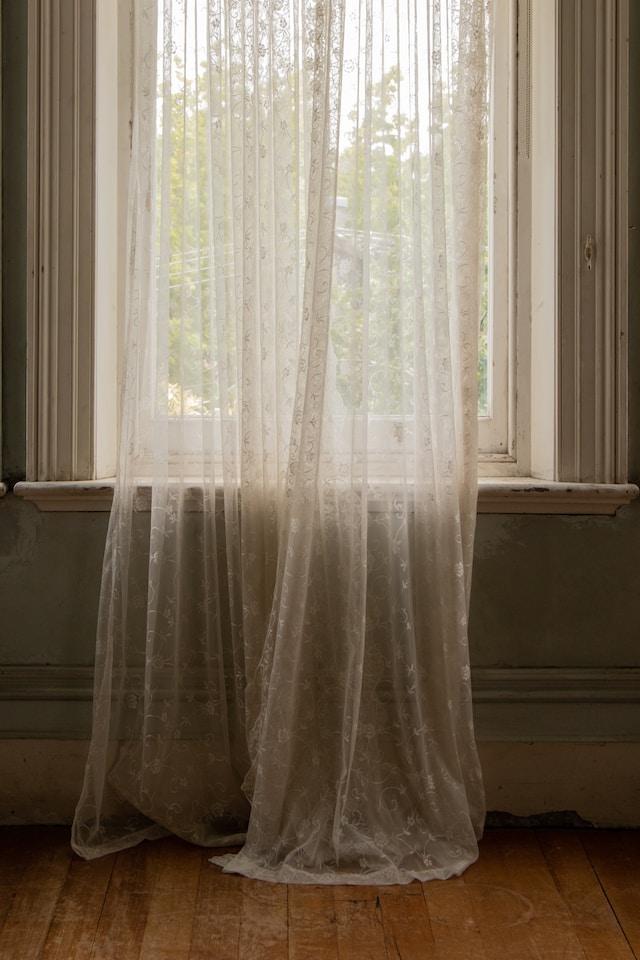How To Shorten Curtains: A Step-By-Step Guide

Curtains are an essential element of any home decor. They frame a window, add style, provide privacy, and control the amount of light that enters the space.
However, curtains tend to have the most impact when it comes to providing a specific aesthetic to the room. How the curtains sit on the windows will determine the look that it has.
Long curtains that drag against or pool on the floor can look cluttered and messy and this can negatively impact your overall decor.
If you’ve purchased or received a curtain from a family member or friend that is too long and just doesn’t sit right on your windows, I’ve got good news for you.
You can easily shorten any curtain to your desired length with just a few adjustments.
These tips will help you every step of the way and if you’re a newbie at DIY projects, this one isn’t as complicated as you may think.
With just a few basic sewing tips, you’ll be able to shorten the curtains in no time and make sure they fit your windows perfectly.
In this article, you will find my best method for shortening curtains which is simple, easy to follow, and cost-effective.
Here is a step-by-step guide that details the entire process to make long curtains shorter:

Table of Contents
Easy Steps To Shorten Curtains
Step 1: Take accurate measurements and mark the main points
When altering any garment or curtain, you’ll want to begin by measuring the curtain and the length of the window.
This can be used to determine how much fabric needs to be removed and adjusted to achieve your desired length.
Grab a tape measure and measure from the top of the curtain to the bottom hem.
You can do this when the curtain is already on the rod or measure the wall length first and then lay the curtain on the floor to measure to that point that matches the preferred length.
Next, use a fabric chalk marker or a piece of chalk to mark the new length of the curtains. If you need to use a ruler to get a straight line, please do so.

Get a fabric chalk marker from Amazon
You’ll want to add an extra inch or so to the length so that you can turn the hem up for a neat finish.
However, if you do end up making the mistake of cutting the curtain slightly off, you can always make adjustments when you turn the hem in and this is why leaving a few inches can be of great help.
The most important task you will have when shortening a curtain is to nail the measurements and place the correct points as this will greatly affect the way the curtains hang on the window.
Step 2: Cut the fabric according to the marked points
Before committing to chopping the length of the curtain, do a quick or thorough check to ensure that you have taken accurate measurements.
Once you’re pleased and confident with your work, you can now proceed to cut the excess fabric.
If there’s a huge portion of the curtain that needs to be removed, you can go ahead and just cut the fabric at the length that you measured.
Alternatively, you can remove the current hem by using a seam ripper to undo the stitches and this should loosen the fabric so that you can cut off the excess.
The extra fabric you left earlier will make it way easier to sew or turn up the hem with a neat finish if you’re using a sewing machine or doing it by hand.
Step 3: Sew the new hem
Here comes another essential step and that’s turning your cut hem into a neat, tidy, and presentable finish.
You can use a sewing machine or sew the hem by hand using a straight or zigzag stitch depending on what’s most available to you right now.
For those that are doing this by hand, consider grabbing a sewing kit that has all the essentials like this one from Amazon:

If you left a slight excess of fabric on the length, turn it up by folding it over twice and pin it into place so that you can reach your desired length. You can use as many pins as needed which will make it easier to keep the fabric in place while sewing.
Pinning the hem is pretty useful that allows you to have a good idea if the length is accurate.
If you don’t know how to use a sewing machine and are not skilled at hand sewing, consider using fabric glue to secure the hem.
Follow the instructions on the packaging to see if it will work for the curtain you are planning to shorten.
The pins can be kept on the curtain until the fabric glue is dried and the hem is sealed.
Step 4: Iron hem for a professional finish
Since you went through all this effort to adjust and shorten a curtain, you might want to consider spending a few extra minutes to make sure the hem sits right.
It’s common for a hem that has been adjusted to puff up in certain areas so steaming the hem or ironing it lightly can help the stitches and steam sit right.
This can also make the hem look like it was initially this way.
Step 5: Hang the curtains
Now that the shortening of the curtain has been completed, it’s time to get it back up on the rod. Simply slide the curtain into the rod and adjust as you see fit.
If you’ve followed the instructions correctly, you should be pretty pleased with your handy work.
As long as you make sure to take accurate measurements, double-check as you go, or even rehang the curtains when they curtain is pinned to the desired length will help ensure you get it right the first time.
However, mistakes often can and do happen more than we like so if you mess up, you can always readjust until you get it right.
Go back and use the fabric pen or marker to pinpoint which areas need adjusting.
Closing Thoughts
I hope this practical and simple guide has been of some help to you so that you can achieve the desired curtain length that you’re happy with.
It’s a good idea you’ve taken the initiative to tackle this project and shorten the curtain.
Curtains can really transform a window area and doing it yourself not only saves you the hassle of having to buy another curtain or spending the extra money to get it fixed which can sometimes end up being rather costly.
As you can see, you don’t need to be a skilled seamstress or tailor to fix a hem. With just a few basic sewing skills and tools, it’s definitely possible.
Measure the lengths correctly, mark the points, cut as straight as you can, and take as much time as you need for each step. This will ensure a professional and satisfying finish!
Now you can stand back and enjoy your work to your heart’s content.
Related Posts:
Curtain Tips: Best Beginners Guide Hands-Down





